“There are free, impudent spirits who would like to deny that at bottom they are broken, incurable hearts”. (Nietzsche contra Wagner 1889)
Nancy Cunard was a pioneer agitator for civil rights for African peoples, in America and the British colonies. She was a passionate opponent of Fascism and Franco in Spain, and through her efforts and at great personal risk, saved the lives of thousands of refugees. She broke behavioural taboos that restricted women, her example surely an influence on early 20th century feminists. She was a star for her generation and an inspiration for later ones.
She has three strikes against her. She was white, British upper class and female. She was for a time a Communist. And she was alcoholic, a drug addict and a member of the counter culture. These characteristics were used by the phlegmatic majority to discount her cause.
She was declared insane and sent to an asylum at the end of her life, the fate of many ‘inconvenient’ females; poor, ill, and abandoned by those she had spent her life in helping. When she died in 1965 she was completely alone. Worse, she could look back at scurrilous attacks from some she had helped, ingrates who bit the hand which had ceased to feed them, in a most barbarous manner.
Nancy Cunard diverged radically from the British upper class into which she was born. Yet despite her beauty and force of character there was always something fragile, something hurt, about her. She was an outlaw with a broken heart.
Nancy knew Louis Aragon, Michael Arlen, Samuel Beckett, Luis Buñuel, Aleister Crowley, Norman Douglas, TS Eliot, Ernest Hemingway, Aldous Huxley, James Joyce, George Moore, Pablo Neruda, George Orwell, Ezra Pound, and the Sitwells, and probably hundreds more (some of these once famous names now somewhat faded). But it doesn’t seem right for her to be remembered just as the associate of a lot of avant-garde artists. You can’t leave it at that. These men were lovers, some of her best friends, some she quarrelled with and some were her protégés. But you can’t just leave it at that either. Nancy Cunard was part of the post war generation devastated by the disaster of WWI looking for new ways, styles, arts and attitudes, disillusioned by the older society who had been so tragically inept. Some protested through their art; Nancy through her life.
There died a myriad,
And of the best, among them,
For an old bitch gone in the teeth,
For a botched civilization
(Ezra Pound 1920)
and Kipling’s take on Simonides:
(Tell them in Lakedaimon, passer-by
That here, obedient to their word, we lie)
If any question why we died
Tell them, because our fathers lied
••
I could not dig: I dared not rob:
Therefore I lied to please the mob.
Now all my lies are proved untrue
And I must face the men I slew.
(Epitaphs, Rudyard Kipling 1920)
What was wrong was wealth, class, prejudice, violence and conformity, and Nancy Cunard waged war on all these evils. She lived a life of defiance and sometimes violent protest, and destroyed her health and dissipated her wealth in the process.
Rebel with a cause
She shocked her contemporaries, for she was a member by birth of the class she despised and blamed. She was born in 1896, the child of Sir Bache Cunard, a minor aristocrat from Leicestershire UK of Canadian descent and a minor heir of Sir Samuel Cunard, founder of the shipping line. Although correctly described as one of the heirs of Sir Samuel’s fortune, Nancy actually received little of it, enough to survive on, just. But her mother Maud Alice Burke was a more substantial American heiress and supported her daughter generously until WWII destroyed much of her wealth. Nancy Cunard was a comparatively wealthy woman for the period 1920-1940, and spent lavishly in support of causes she thought important.
For any who remember the early 1960s the parallel to Nancy’s impact on her contemporaries that comes to mind is the rock and roll star. People like Elvis Presley in the 50s, Mick Jagger in the 60s, Prince in the 70s. These people had wealth, fame, flaunted their sexuality and lived to a different moral code. To the societies they moved among they were outrageous and dangerous people. They were harassed by police and some, like John Lennon, were killed.
Nancy Cunard was famous for her looks, tall, thin, almost gaunt, graceful, beautiful, with eyes some never forgot; she had sex appeal, and flaunted it, to the shocked fascination of her contemporaries. She had the exoticism of a Rudolph Nureyev. She was fashionable, trendy, intense, and distressingly straightforward. The British upper class were not amused.
The most hostile response is reserved for those who betray their rank. Wealthy rock stars from the lower and middle classes can be a figure of fun. But those who attack wealth and privilege from within the upper privileged class are hated. People for example like Lord Edward Fitzgerald ‘the republican lord’ who renounced his title under the influence of the rhetoricians of the French Revolution and was murdered in an English prison for fighting for freedom for the Irish.
In America you can amass wealth but you cannot also campaign for social justice. It’s one or the other. The Kennedy brothers were murdered because the FBI thought they were communists. John Lennon was murdered because he said Christianity was in decline. These fantasies were more important to the killers than any ‘message’ the men really had to give.
It’s hard to remember these threats. The trouble with revolutionaries is that we get used to them. But this is the best way to remember Nancy Cunard. As an anarchist, someone who told titled people they created social injustice, to go rattle their jewellery. A class rebel who led a life of indulgence in sex, drugs and revolutionary poetry.
Dangerous ideas
Nancy Cunard challenged people’s ideas. New ideas are dangerous things. They’re like machine gun bullets, they can destroy the fabric of lives. People who have been educated sometimes forget this. Ideas come to them in processed and prepackaged forms, as courses, presented by professors, and if they show they understand them, they too become professors. But ideas are not originally like this. They can show you yourself as a fraud, as a liar, a whitened sepulchre. Don’t blame the man of simple ideas who uses a gun to protect himself, or crucifies his teacher. The book is indeed the good book: but many who read it are illiterate. Uncomfortable ideas, we too often think, must originate with madmen.
Nancy began as anthologist, with three great publishing ventures. She gathered together (and contributed to) some of the best contemporary poetry of the WWI years. Wheels 1916 was finally edited by the Sitwells, a group of poets protesting at the tragedy of the Great War. Then, while living in France Nancy learned typography and how to operate a printing press and became a publisher. The Hours Press 1928-31 published some of the most beautifully designed books of the period, works by Louis Aragon, Norman Douglas, Samuel Beckett, Robert Graves and Ezra Pound. And in 1933 came Negro.
Negro was an immense book published by Nancy Cunard which was a statement of African achievement in politics and the arts, inspired by her association with Henry Crowder, who had been her lover since 1928. Crowder was an unsuccessful black musician from Atlanta Georgia USA, and what he had to tell Nancy about the condition of black people in the southern states of America changed her life. Negro was not significant for its publication alone. For five years Nancy corresponded with black leaders around the globe asking for contributions for her book, and with white writers asking for their reactions to what she was sent. Nancy at this stage of her life had a large circle of friends and acquaintances. She knew hundreds of people. What she was attempting became both celebrated and notorious long before it was published. It was the first book of its kind, almost the first attempt of any kind, to show African achievements across a wide spectrum. Nancy corresponded with leaders such as W.E.B. Du Bois, with whom she differed over how protests should be made at the mistrial of the ‘Scottsboro Boys’, a case of racial injustice of 1931. Nancy found Du Bois too cautious: she would have much preferred Martin Luther King Jnr had she known him. Unfortunately Negro’s main effect was to ostracise Nancy from upper class white society while injustices still proliferated towards African peoples around the world. ‘Negro’ is still a ‘sensitive’ word.
The book was accompanied and preceded by another, an attack on the British upper class and its racial prejudice; and on her mother Lady Emerald Cunard who had made derogatory remarks about black people. For a white aristocratic woman known to be living with a black man this was reckless behaviour. Nancy had in many circles of her acquaintances burnt her boats. That was the way she wanted it. She was an all or nothing kind of person. Far from being a politician, she was passionate and committed about her beliefs.
Nancy Cunard was a martyr to a cause just as much as Lord Byron was. Byron puzzled and outraged his contemporaries before sacrificing himself for the independence of Greece from Turkish rule (Byron was in fact killed by his doctor who bled him for a wound not necessarily fatal). “The proud and lonely hero marked by destiny who refuses society’s moral claims…in whose past there is a secret…He is wild… but of high descent; his features are hard and impenetrable but noble and beautiful; a peculiar charm emanates from him…” (Isak Dinesen was romancing about Lord Byron, from an adolescent story quoted in Judith Thurman’s biography of Dinesen, but could be talking about Nancy Cunard).
Spanish Civil War
In 1936 Nancy Cunard took part in the war in Spain between the Republic and the Fascists. People all over Europe, not yet aware of Stalin’s takeover in Russia, saw the war as a simple fight of democracy against totalitarianism. With Italy and Germany in the hands of the Fascists, it was vital to stop them in Spain. At this stage Nancy, like George Orwell, was a committed Communist (this was long before Animal Farm was published). In Spain Nancy worked as a reporter. In Madrid she met the Chilean ambassador Pablo Neruda, who was to become a close friend.
She was “quixotic, unalterable, fearless and pathetic” Neruda said. The union of courage and vulnerability in her was noticed, not for the first time.
Orwell arrived in Spain about the same time in 1936. Later, he was to document the split within the Communist factions supporting Trotsky and Stalin in Homage to Catalonia (1938). For Nancy it was much simpler: Fascism was the enemy. Back in France in 1937 Nancy organised a statement in support of the Republican forces by almost 150 eminent writers and public figures. She returned to the Spanish border at the time of the fall of Barcelona to Franco’s forces in 1939 as a reporter for the Manchester Guardian and wrote a series of articles exposing the plight of refugees into France, held in insanitary compounds, some of them starved to death and many dying of infected wounds. The French government at this stage was not sure how to handle the situation. Nancy persuaded the Guardian to start a subscription fund for the relief of the refugees. She spent time near the firing line at risk to her life, exposed to machine gun fire and bomber raids, giving what care she could to the sick, leaving herself at times without money, clothes or food.
Nancy’s reports embarrassed world opinion about the Spanish war and the plight of the half a million Republican refugees: the initial reaction had been to sweep the matter under the carpet. Help was now given by many countries; and the fund she helped start led to medical attention and food supplies arriving in France which saved thousands of lives. To the end of her life the war remained a matter of right versus wrong for her, without a suspicion of political awareness on her part. Talk about quixotic!
The mad and the sane
Nancy Cunard knew people, hundreds of them. She was wealthy, aristocratic, fashionable. Some loved her, some admired her, some thought she had social cachet or snob value. She herself was curiously uninvolved. She viewed herself with uncommon detachment. She seems to have loved causes, poetry, justice, freedom, more than she loved people, even herself. This was part of her allure, her charisma.
This attitude led to some self destructive acts. In 1931 she attacked her mother publicly for racism, and had her allowance drastically reduced. From 1928 onwards, in Paris and elsewhere, she adopted an anarchic lifestyle, drinking to excess, taking little food and experimenting with various drugs. In lieu of long term relationships she took more and more to casual sex initiated by her. This behaviour in a young man would seem normal. In a young woman during the 1930s it was shocking. In a middle aged woman it began to seem eccentric. Towards the end of her life she refused to eat at all. There were several instances where she may have attempted suicide. She was tarred with the brush of insanity, and her friends stayed away, as they still do from this ignominy. Few stopped to think her heart might be breaking, her courage faltering. She was still magnetic, still took lovers half her age. But she was ceasing to savour life. She was lost without a cause.
The lonely hunter
Always wilful, Nancy had been like that character who said: “I always get what I want. Then I don’t want it” (was that a Scott Fitzgerald story?). The origin of her attitude to life lies in her relationship with her parents: parents are the source of all our neuroses. Not their actions so much, but how we interpret them. Nancy’s father Bache was an inarticulate man who didn’t understand his wife or his child, and took refuge in the hunt, and in metalwork projects. He was well meaning, but probably puzzled Nancy a good deal when she was a child. Her mother Maud, or Emerald, was polite, gracious, generous and vapid. Non threatening to a degree, she approached silliness, and was loved by just about all the guests she entertained in her career as society hostess. She was benign but not affectionate. She probably didn’t want a child, nor loved the daughter she had nor the husband she separated from. Perhaps Nancy hated her for that affable neglect. She grew up wayward, wilful and defiant.
In 1916 Nancy married an Army officer called Sydney Fairbairn, perhaps under the cloud of war, perhaps just as much to defy her mother, who was against the match. The marriage lasted, according to Nancy, 18 months, though it was some years before the couple divorced. They were obviously incompatible, the marriage an act of wilfulness on Nancy’s part. She seemed to experience a kind of horror in contemplating it afterwards. The following year she fell in love, most likely for the only time in her life. The man was another Army officer, a more congenial match for her: his name was Peter Broughton Adderley. In 1918 Adderley was killed in combat, months before Armistice Day. It broke her heart; she never recovered from the blow, though she made light of it to others, nothing if not stoical.
Aged only 22 years, this gifted and privileged aristocrat turned to other spheres than marriage for fulfilment. At first poetry, the poetry of protest. Then the battle against racism and fascism. Nancy must have been trying to undo a wrong, the wrong of a world war which had taken the man she loved and wasted his life futilely. But you can’t undo the past.
You smug-faced crowds with kindling eye
Who cheer when soldier lads march by,
Sneak home and pray you’ll never know
The hell where youth and laughter go.
(Suicide in the trenches, Siegfried Sassoon)
The writer Raymond Mortimer knew Nancy Cunard well. Remembering her impact, he said, everyone “can look back to some person incomparably bewitching; I have never met anyone to equal Nancy Cunard…anyone with a a vivid response to life and beauty and intelligence would take to Nancy…she was irresistible. Never in her life, I believe, was she frightened of anything”. Yet with all her gifts, the war wasted her life just as surely as it wasted the 16 million dead and as many again wounded. Perhaps the most remarkable thing about her was that right up to the end of her life people who met her thought her beautiful. Time and alcohol and malnutrition couldn’t destroy what she had: altruism, passion and grace.
There are two biographies of Nancy Cunard recommended by critics: Lois Gordon’s Nancy Cunard: Heiress, Muse, Political Idealist. Columbia UP, New York 2007; and Anne Chisholm’s Nancy Cunard: A Biography. Sidgwick and Jackson, New York 1979. I’ve read the book by Chisholm, which motivated this essay, and recommend it highly.
A note on Nancy the heiress
Nancy Cunard received an inheritance from Sir Samuel Cunard’s estate through her father, Sir Bache, who was Sir Samuel’s great grandson. When her father died in 1925 Nancy received the sum of £14,400 (US$21,800) in his will. This was the only money she ever had aside from an allowance from her mother from 1920 onwards, sufficient for a rather extravagant lifestyle. No details of this amount are known. The amount was curtailed in 1931 following Nancy’s public attacks on her mother and the stock market crash of 1929. By 1962, when her mother died, Nancy was living on £600 a year and finding it difficult to make ends meet. When she died in 1965 she left an estate of $120,000. These details come from Anne Chisholm’s biography. What the figures show is that by 1925 Nancy was a millionaire in today’s figures (an inheritance of over US$1m) yet by 1962 had spent nearly all of it on real estate, printing presses and their books, support for artists and donations to charity. Her last fifteen years were needy.
©2015 Original material copyright Phillip Kay. Images and other material courtesy Creative Commons. Please inform post author of any violation.




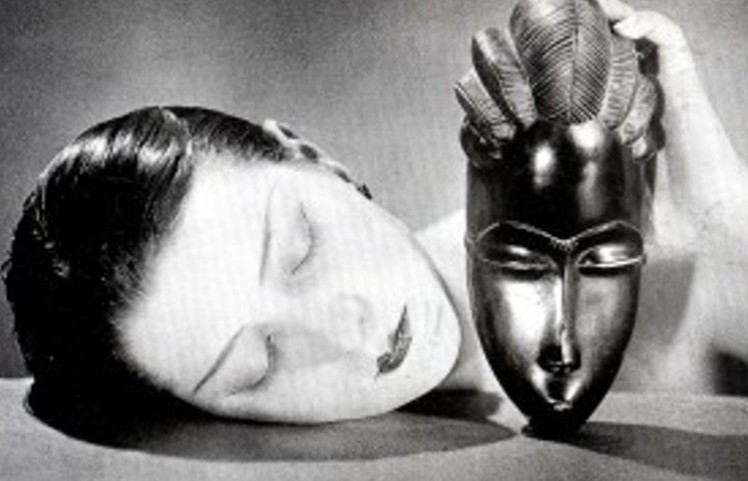
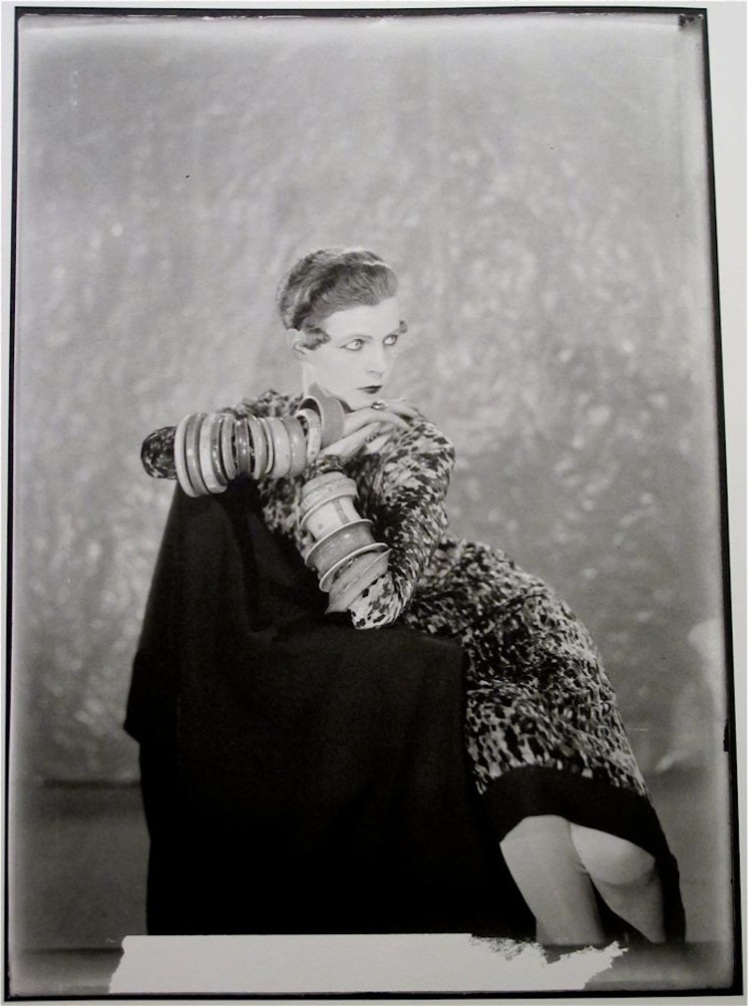
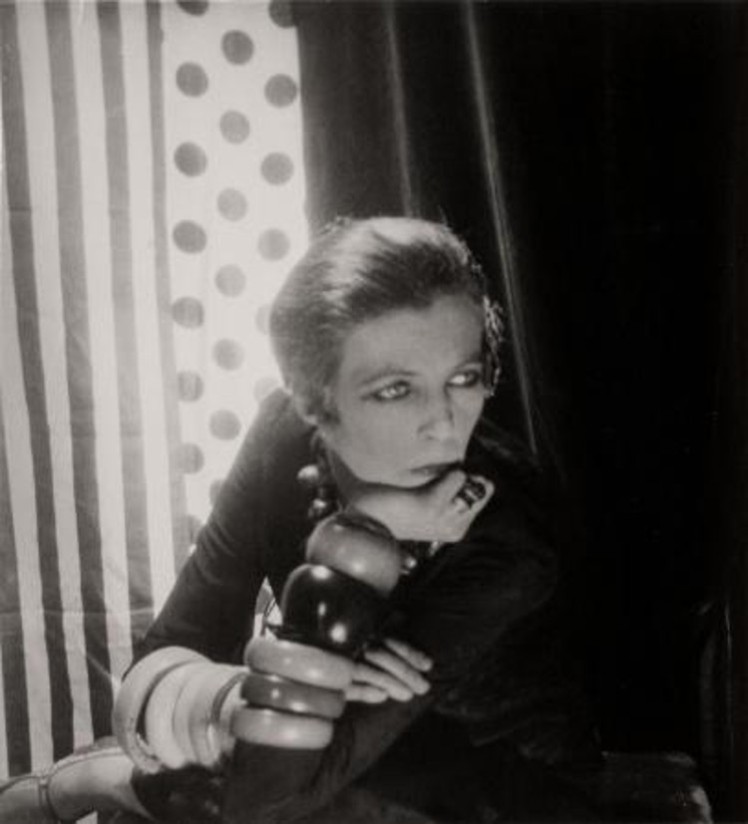
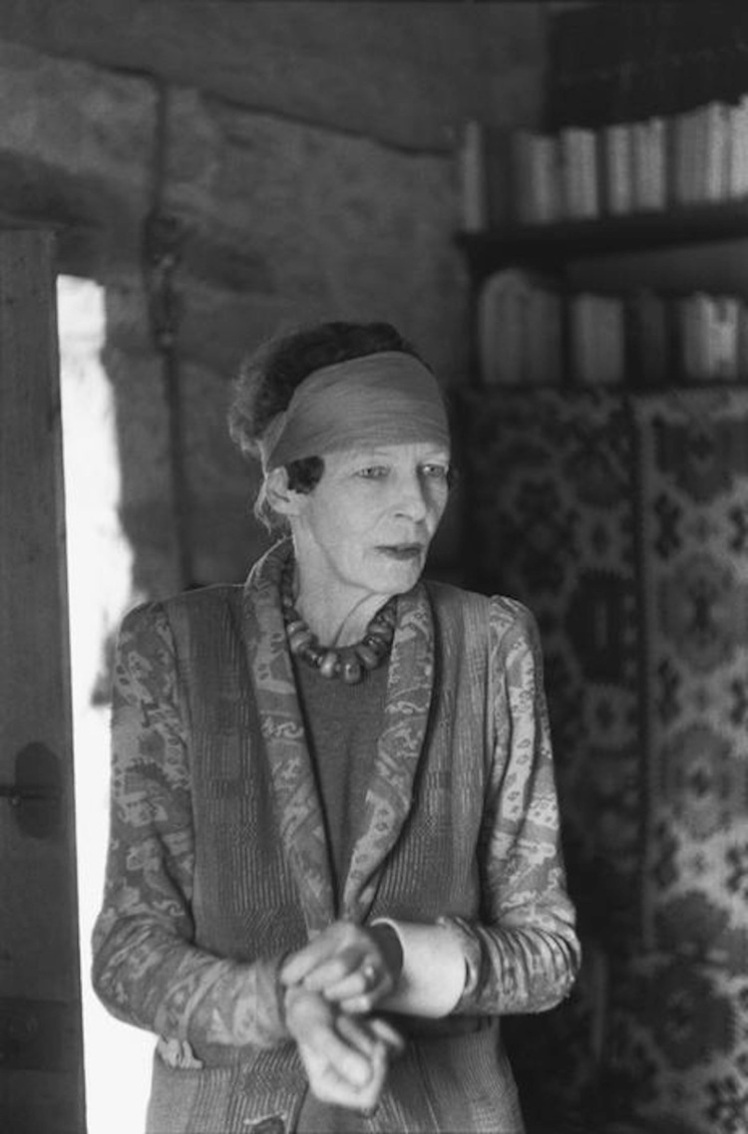
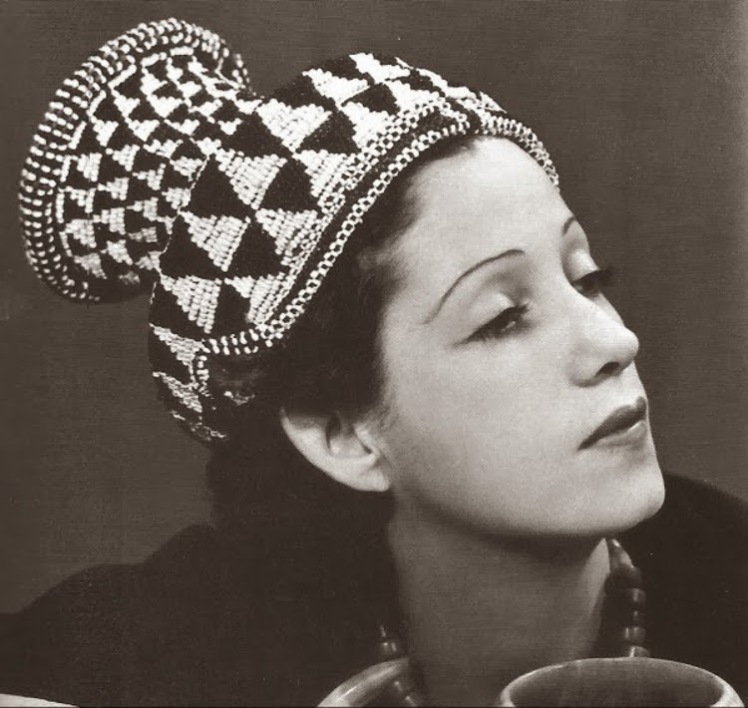
Helo,
Do you know the name of the photographer for the last portrait you show in this text?
Thank you for your answer
Doina Lemny
My notes for this essay say the photographer was Man Ray, but I can’t confirm, though I’ve searched the net. I like this one a lot. Phillip
Absolutely fantastic and engaging. Thanks